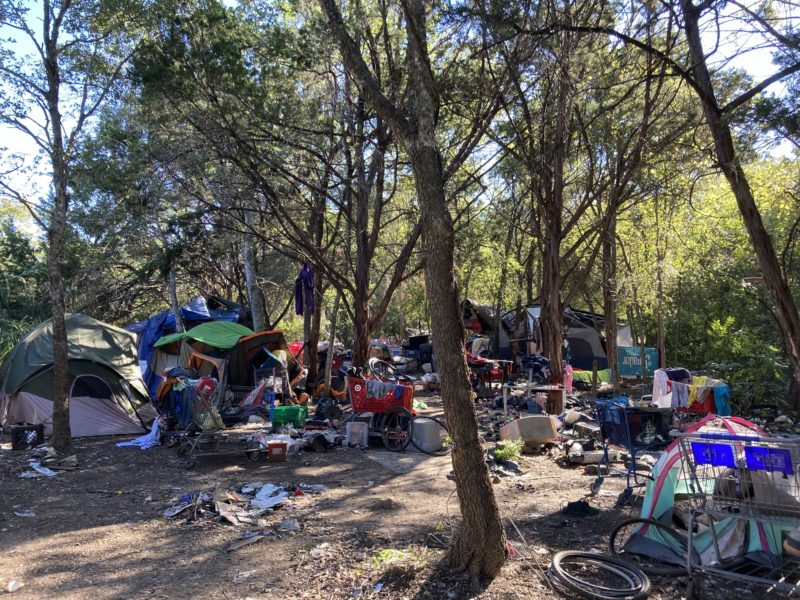City of Austin departments have collected at least 1,045 tons of trash during cleanups of more than 70 encampments since August 2021, according to Homeless Strategy Officer Dianna Grey.
That’s equivalent to about two million pounds, which is the weight of about 500 cars.
The public debate around homeless encampments generally has focused around concerns of public safety or humanitarian need. But Grey’s revelation also highlights the extent to which the encampments have become an environmental challenge.
To mitigate the environmental impact of the camps, the city installed garbage bins and portable toilets at some locations in recent years.
The cleanup efforts at camps date to August 2021, when the city initiated the final phase if its phased approach to enforcement of the Proposition B ordinance banning public camping, which voters approved in May 2021.
Prior to August, large camps with semi-permanent structures flourished in parts of the city, a trend largely tolerated by the city, which had removed an anti-camping ordinance from its books in 2019.
Even after voters approved Proposition B in May last year, police officers weren’t allowed to cite anyone for violating the ordinance until mid-July, and they couldn’t make arrests until August. Arrests and citations remain rare, but the threat of them has empowered city departments to clear more encampments. Grey told a work session of the City Council on Tuesday that early efforts focused on underpasses, after which the focus shifted to public parks.
“Just as an indication of the amount of work that’s being done, we asked some of our public space partners to provide us with some indication of the amount of refuse that has been collected from sites in general. Austin Resource Recovery is 829 tons. Much of that is from just a couple of encampments. Public works: 177 tons. That’s from under overpasses. And Austin watershed: 38.5 tons,” she said.
Grey noted that the number of camps and the amount garbage is straining budgets and staff resources. “We’ve seen accelerated spend-down on our third-party cleanup contracts in some cases.”
“And I think it’s important to note that what we’re finding is in the larger, particularly more remote sites, often they have very complex access where we have to cut down trees to create paths for heavy machinery and are taking in some cases not just multiple days, but sometimes weeks to clear.”
Because of the strain on city resources and the large number of city departments involved in the cleanups, Grey said that her office worked with the Office of Performance Management in the Financial Services Division to “identify pain points” and advise on process management.
The cleanups involve different protocols and many moving parts. For instance, there are protocols for handling private property to ensure respect for the belongings of homeless persons, and for handling biohazards found at the camps.
Despite the massive amount of waste collected, Council Member Sabino “Pio” Renteria complained about a lack of progress. “I have in my district (camps) all along Pleasant Valley, all along Riverview. I mean there’s another homeless camp up there, it’s huge. It’s really huge and a lot of people are calling my office… it’ll be a while before we’re going to have the capacity to even make a dent in this problem. And what’s going to happen?”
“Are these people going to be camping there until we find a place for them, or bridge housing? It’s a little bit frustrating… We have some people that are out there that are very ill, and I mean they are just destroying the park. You know, they’re littering all over the place.”
Renteria added, “We need to address those kind of issues immediately because we can’t have that—all this trash and whatever else being deposited out there right in front of our face where we have all the ballparks, where we have development going in that area.”
Cold Weather Shelters
Another challenge is offering emergency shelter to the homeless during cold snaps, when it can become dangerous to spend the night outside. Grey noted that the city has a reverse text messaging system for people experiencing homelessness to inform them when cold weather shelters are open.
The city currently runs cold weather shelters at three parks and recreation centers, which are activated when the temperature is below 32 degrees, or below 35 degrees when it is raining or very windy.
Grey said the three shelters currently have a capacity of 225, which is below the pre-Covid capacity. CapMetro makes available buses to transport campers from assembly sites to the shelters.
The shelters are staffed by Parks and Recreation Department staff, usually with APD on site as well. “Historically, much of cold weather shelter operation depended on our faith-based community who opened up churches and provided food and volunteers,” she noted. But because of Covid, “Most of those churches elected not to participate at this time, so the operation has fallen back more onto the city since last year.”
The city has no dedicated budget for operating the cold weather shelters. “I think that we are really at a point of reconsidering whether our cold weather shelter plan reflects where we are as a community with the size of our unsheltered population and many of the chronic conditions that we see in the unsheltered population,” Grey said. “So we are really beginning to try to outline what the options are for enhancing the cold weather shelter operation and what the resource implications might be.”
